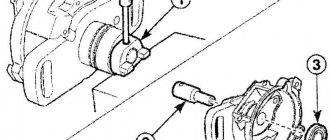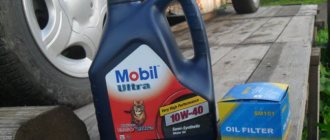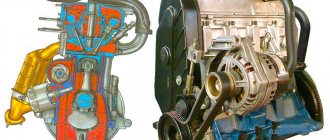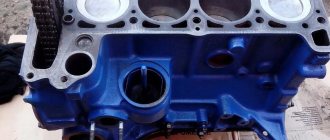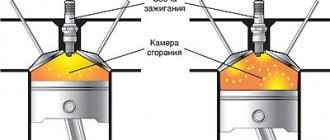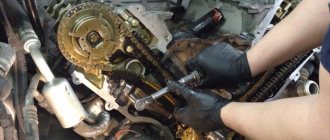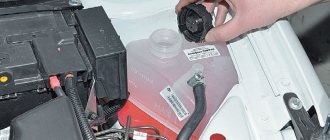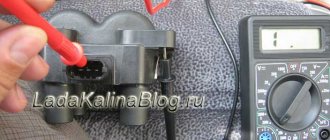Engine oil Lada Largus
There is no water on this page.
A pure summary of information from all resources and a little bit of my opinion. I analyzed the website data and selected the best oils for the Lada Largus engine. If it was useful, rate the material or leave your opinion in the comments, I’m happy to answer any questions! FAQ, educational program on selection:
- What viscosity is suitable for the Lada Largus engine? Suitable for 0w30, 0w40, 5w30, 5w40, 10w30, 10w40,15w30, 15w40. Depends on the environment and engine condition.
- What is the oil volume in the Lada Largus engine? 4-5 liters will be enough. Look at this point in the article, the volume depends on the engine model.
- What is the oil change interval for Lada Largus? Every 10,000 km or once a year, depending on the model. But I recommend changing it more often :)
Device and characteristics
The engine marked K4M is a high-tech power unit with high performance. The first production of the power unit began back in 1999. The motor design is quite simple and understandable. The only difference from its younger brother K7M is that there are two camshafts in the cylinder head.
Also, the engine is much quieter because hydraulic compensators are installed. The engine is equipped with sixteen valves, which increases power characteristics and slightly reduces fuel consumption. The average engine life is 350,000 - 400,000 km.
Main technical characteristics of K4M
The French engine was also equipped with gearboxes from Renault cars with JR5 or JH3 markings, which were also installed on Logan.
Criteria for selecting Lada Largus oil
All oils are selected based on compliance with SAE, ACEA, API. In terms of composition, it is optimal to use semi-synthetics or synthetics for Lada Largus.
Viscosity is suitable 0w30, 0w40, 5w30, 5w40, 10w30, 10w40,15w30, 15w40, but most often drivers fill in 5W-30.
Information on viscosity for a specific engine can be found in the motor oil interchangeability catalog: https://www.northsealubricants.com/en/oil-advisor
The catalog can be trusted, the data is taken from car manufacturers. In this case, you can choose not only oil for the engine, but also for the gearbox, power steering, brake system, and cooling system. That is, all liquids.
Original Lada oils
- LADA PROFESSIONAL 5W-40, semi-synthetic, Article number 1 l - 88888L15400100.
- LADA PROFESSIONAL 5W-40, semi-synthetic, Article number 4 l - 88888L15400400.
- Lada Ultra 5W-40 API SN/CF, synthetic, Article number 1 l - 88888L05400100.
- Lada Ultra 5W-40 API SN/CF, synthetic, Article number 4 l - 88888L05400400.
At the factory, the Lada Largus engine is filled with Elf Solaris Rnx 5w30 oil.
Sequence of work
- Drive the car onto the overpass, warm up the engine to operating temperature
- Get under the bottom of the car. The first step is to dismantle the motor protection, if any. To do this, unscrew several bolts
- Using a rag, thoroughly wipe the oil pan from dirt and deposits. In particular, pay attention to the area around the drain plug - it must be perfectly cleaned and degreased
- We unscrew the drain plug and observe the process of draining the waste liquid. Old oil will flow into a pre-prepared pan
- We wait until the oil is completely drained, then screw the plug back in. We measure the amount of drained liquid. This is very important, because this is exactly how much new oil will need to be introduced into the filler hole.
- There is a steel washer in the drain hole that may need to be replaced
- The next stage is replacing the old filter element with a new one. To do this, we use a special key, and smoothly unscrew the filter and carefully remove it from the thread. If there is no special key, you can use a screwdriver instead to pierce the filter housing. In this case, the screwdriver will act as a lever. Pull it towards you and unscrew the filter
- Clean the seat for the new filter from deposits. Dirt, grime, dust and metal shavings usually accumulate there. After cleaning, place a new element in the seat
- We provide access to the engine compartment and pour new engine oil into the corresponding hole, having first removed the plug. At least 5 liters of fluid must be administered. Then put the plug back in place
- Start the engine and wait for the oil pressure warning light on the dashboard to light up. It is important that this indicator goes out on its own after a few minutes
- Once again we climb under the car and check the reliability of fastening of all screw elements, if necessary, wipe all surfaces from oil stains
- Please note that all this time the engine remains on, starting from point 10. We measure the oil level using a dipstick and add fluid if necessary. At this point, the process of changing the oil in the 16-valve Lada Largus engine has been successfully completed.
Recommendations for choosing engine oil for the LADA Largus engine
Lada Largus is a car jointly produced by the AvtoVAZ and Renault-Nissan concerns, which has several different modifications: Largus R90 - with 5 or 7 seats, F90 - a small cargo van and Cross in black and white. These cars operate on injection 8-valve and 16-valve internal combustion engines, which determines their power - 87 or 105 horsepower, and have environmentally friendly particulate filters and recovery catalysts. The fuel and lubricant is selected according to its characteristics. You can read about what kind of oil to fill into the Lada Largus engine in the documentation supplied with the car - for 16 valves and 8 valves the requirements will be slightly different.
Video review of the VAZ 21129 1.6 l 16 valve engine from Lada Largus
Firstly, the 21129 engine is a modified version of the 21127, which differs primarily in toxicity standards. 21129 is adjusted to EURO-5 toxicity standards in order to obtain approval under current legislation.
Secondly, the compression ratio has been changed. 21129 the engine was literally “unclamped” to make it possible to use AI-92 class fuel. The 127 engine did not have this option.
Thirdly, the 129 1.6 Lada Largus engine with 16 valves has a modified intake and exhaust, which has a positive effect on the dynamics of the car.
Fourthly, the 129 motor runs under a new engine control unit with a modified program.
Fifth, the engine mounts have been modified to reduce vibration from the powertrain.
And this is just a small part of the changes that affected engine 21129. In fact, there were much more, but alas, many, seeing that the engine is similar in appearance, think that no changes were made. If we dig deeper, we will see that the piston rings have become thinner and the piston has become lighter. This was done to reduce friction and increase engine life, as well as improve the overall performance of the engine.
What kind of engine oil was filled in from the factory?
When you buy a new car from Largus dealers, Elf Solaris Rnx 5w30 synthetic all-season engine oil is already poured inside it (for moderate climates with summer temperatures no more than +25 degrees and winter temperatures up to -30). After purchasing a car, fuel and lubricants can be changed immediately or wait until the mileage reaches 15 - 30 thousand km. It is not necessary to use the exact oil for the Lada Largus that was filled at the factory - pay attention to other brands recommended by the manufacturer.
Engine tuning
Many motorists want to make their engines better and more powerful. This is why the tuning and modification procedure is carried out. For engines such as the Lada Largus, there are two options for modification - mechanical and software tuning. But, most vehicle owners prefer to make a second modification.
So, what is meant by software modification - chip tuning Largus. Chipping engines is a common procedure these days. In this case, there are two subtypes of the operation. Let's look at each one separately.
Soldering the chip into the ECU
In order for everything to work out and not have to often stand in line to see an electrician-programmer, the ideal option is to install a chip in the engine control unit. After this, the software is installed, and subsequently the chip regulates the operation of all necessary systems.
How is the actual process of introducing a chip into the “brains” of a vehicle carried out? This procedure is quite difficult and requires advanced knowledge in radio electronics, as well as automotive electrical engineering. So, this process is best left to specialists.
The chip itself can be mounted (soldered) directly into the electronic engine control unit or at an intermediate stage, depending on the purpose of the equipment.
Recently, controllers and various chips that motorists install into their cars themselves have become popular. As practice shows, this does not always have a positive effect on the performance of automotive systems. Experts and auto electricians recommend that before installing anything in a vehicle, consult with professionals and weigh all the pros and cons.
Brain firmware
The second option is chipping the standard engine control unit. Motorists and craftsmen divide this type of tuning into three parts:
- Firmware to reduce fuel consumption.
- Firmware to increase power.
- Balanced firmware.
As practice shows, most owners of Largus engines use the option with reduced consumption. It is worth understanding that by reducing the flow rate, the dynamic characteristics are also reduced. Thus, power units may respond late to changes in the position of the accelerator pedal, which in turn does not have a very good effect when overtaking.
The big advantages of chip tuning include balanced chipping. This option is the most suitable for the engine itself. Thus, the fuel mixture is supplied in the required quantity to the cylinders, and combustion occurs completely, since the ignition timing is set ideally.
It is worth noting that the chipping procedure must be trusted to professionals. Only they will tell you what type of tuning is most suitable for the engine and will take into account the wishes of the motorist.
Renault company recommendations
If you haven’t found Elf Solaris Rnx on sale or you’re not satisfied with the price, then choose one of those oils recommended by Renault to fill in your Lada Largus. These are brands such as:
- Shell PC 1448 0W30, PC 1021 0W30 - low-viscosity all-season oils (may need to be replaced with a more viscous lubricant if you live in a hot climate) on a synthetic basis, recommended only for 8-valve engines;
- ELF Solaris MSX 5W-30, ELF Excellium NF 5W-40, ELF Evolution SXR 5W40 – more viscous fuels and lubricants compared to the previous ones;
- Lukoil Genesis RN 5W40 is a domestic oil of moderate viscosity.
Conclusion
The Lada Largus engine 16 valves with a volume of 1.6 liters is a powerful and at the same time reliable power unit developed by the French company Renault. The engine was installed on cars of the Volzhsky Automobile Plant for quite a long time.
But, subsequently, the company’s management decided to stop equipping domestic cars with the K4M power unit. This was done to reduce the cost of vehicles.
Expanding the model line of the domestic automobile industry is a rather complex process that took a long time, and each new model turned out to be a very high achievement for the company. AvtoVAZ today is considered the largest car manufacturer in Russia, but its own developments within the company are becoming less and less. One of the successful models was the successor to the Renault Logan MCV station wagon. In the Russian version, this car was called Lada Largus, and potential buyers of domestic vehicles still had certain doubts about the technology of this car. Someone claims that the car is equipped with a Russian engine, modernized since the time of the “Classics”. Others say that under the hood of Largus there is a brave Frenchman with good potential. Today we will look into the characteristics of the Lada Largus.
It must be said that the engine was not the only question that directly arises from the car buyer. In some cases, Lada customers asked questions about assembly, as well as about the choice of plastic body parts. Many car buyers also had doubts about the lack of intervention by Russian engineers in the suspension. Many claims turned out to be groundless, since most of the technologies and components of the car, however, originate in France. Engineers in Russia changed very few parts in the car, most of which turned out to be unnecessary replacements. But the Russian concern could not produce an exact copy of Renault due to the terms of cooperation with Renault-Nissan.
Which oil to choose for a 16 valve engine
For 16-valve Lada Largus R40 and Lada Largus Cross, oils with the following characteristics are best suited:
- 0w30, 0w40 - for winter or harsh northern climates, where 0 is the range of permissible temperatures for “cold” engine starting, at which the oil does not harden and lubricates the parts well (in this case, up to -35 degrees), and 30, 40 - this is an indicator of low viscosity;
- 5w30, 5w40 - all-season fuels and lubricants for the temperate zone, where frost does not fall below -25 degrees;
- 10w30, 10w40 – for warm southern climates, where the temperature is not lower than -20;
- 15w30, 15w40 – summer option, for regions where the thermometer does not drop below -15.
These recommendations were compiled by AvtoVAZ experts without indicating brands and possible manufacturers. That is, we pour oil into the Lada Largus Cross and Lada Largus R40, where according to SAE the first digit is no less than 5 (for example, 5w30). 0W30 is not suitable for such cars
Motorists' choice
Sometimes motorists have a different approach to choosing engine oil for a Lada Largus car and, based on their experience, offer names that are not included in the list of recommendations:
- Lukoil Luxe SN 5W40 – all-season synthetics;
- Shell Helix Ultra 5W40 - unfortunately, in this case it is easy to buy counterfeit oil;
- ELF Evolution 900 FT 0W30 – for the Largus R90 model;
- Nissan Oil 5W40;
- GM Dexos 2 5W30.
The oil should not be too viscous, otherwise it will harden in the engine, and for Largus this is fatal, since minimal gaps are left between the parts. Now a little about how much lubricant is required per fill. The crankcase holds 5 liters. It is necessary to fill it with fuel and lubricants until it is full, also changing the filter (the last condition is important for 16-valve engines).
At the same time, the car is driven into a garage with a pit, the engine is warmed up, then the ignition is turned off, the crankcase is opened and the used lubricant is drained. The new filter is impregnated with fresh fuel, the rest is poured into the internal combustion engine and the engine is turned on to check using the indicators whether there is enough fluid. It is not necessary to carry out all the manipulations yourself - you can trust the service station workers, especially since getting to the crankcase in the Lada Largus is not easy.
Disadvantages of the Lada Largus 1.6 16 valve engine
1. The first and most unpleasant drawback that the 1.6 engine from Lada Largus has is increased oil consumption. Although, according to the manufacturer’s stated data, the maximum oil consumption should not exceed 100 ml per 1000 km, in fact this figure can be 2.5 times higher. Of course, this problem will not affect many at all, but for many it will be an unpleasant surprise.
2. The second significant drawback is the bending of the valves when the timing belt breaks. Yes, engine 21129 bends the valve when the timing belt breaks. Unfortunately, nothing can be done about this problem. There is only one way out - timely change the timing belt and rollers and monitor their condition.
3. The third drawback is the knocking of the hydraulic compensators. Since valve clearance is regulated by hydraulic compensators, they tend to knock. This can occur both on a cold engine and on a hot one. Most often, this problem is caused by low-quality engine oil or its untimely replacement. But this drawback exists and does exist.
What kind of oil was filled in the engine from the factory?
Both the 8 valve (K7M) and the 16 valve (K4M) at AvtoVAZ are filled with new synthetic oil ELF 5W-30 RN0700 . Salespeople at a car dealership will also recommend this oil to you. Classification according to ACEA A5/B5 - according to API SL/CF.
Judging by many surveys on websites dedicated to servicing Largus, many adhere to these recommendations.
But you can use other oil. The main thing is that it corresponds to the quality class and viscosity level specified in the instruction manual. ASEA oil class - A1, A2, A3 and A5; by API - SL, SM and SN.
Leaders include Shell, Lukoil and Zic.
How to replace the oil filter
You will need : a 10" or 13" wrench, a puller or a screwdriver.
On the K4M engine, access to the oil filter is blocked by the engine protection, which will have to be removed (6 x 10 screws). Or remove the fuel frame protection from above by unscrewing the 2 “13” screws. Place an empty container under the filter and turn it counterclockwise using a puller.
If you don’t have a special tool, you can use a screwdriver. For easier access to the filter on the K7M engine, you can remove the exhaust manifold thermal shield by unscrewing the three mounting screws. Then pierce the filter housing with a screwdriver (closer to the bottom of the filter, so as not to damage the motor fitting), unscrew the filter, using the screwdriver as a lever.
Fill the new filter 1/3 full with new engine oil and lubricate the sealing ring with it. Then install the oil filter, tightening it by hand until the O-ring comes into contact with the cylinder block. After this, tighten the oil filter another 3/4 turn.
Features of an oil change in Largus
1. Square key for 8;
2. New oil filter for a gasoline engine (7700274177). Be careful, there are fakes;
3. Drain plug washer or pan gasket (110265505R). Under this article it is steel with a rubber insert in the center. It may be completely copper. Both types cost 30-35 rubles;
4. Container for draining. An old canister of oil or windshield washer fluid is handy. It's also helpful to find something like mosquito netting or old tulle to put over the canister. This way you won’t have to look for the drain plug;
5. Naturally motor oil and straight arms;
From my own experience, I can tell you that you don’t have to drive into a pit to drain the oil from the crankcase. On a flat surface, you can easily crawl under the front end to the drain plug.
The procedure for changing the oil is as follows:
1. On a hot engine, unscrew the drain plug and drain the used oil. It’s better to take your time and wait about 30 minutes. During this time, the engine will cool down and you won’t get burned when you unscrew the oil filter;
2. Unscrew the oil filter. You'll probably need a puller. I advise you to buy a “Crab” puller, they are available everywhere, but the cup puller needs to be selected according to the size of the filter;
3. You can slightly unscrew the engine filler cap;
4. Tighten the drain plug!
5. Install a new filter, having previously lubricated it with oil. Important: you don’t need to tighten too much, just hand effort is enough! If you tighten tightly, the next time the filter will be difficult to unscrew;
6. Fill in the required volume of new oil, periodically checking its level with a dipstick;
7. Start the car and let it run for 2 minutes;
Articles (must read!)
The plug is unscrewed from the bottom of the crankcase. It is supplied with a washer. These parts are not sold as a set, only individually.
Drain plug and washer
The article number of the plug is 7703075348. We were able to find three articles for the washer: 110265505R, 8200641648, 7703062062. In the latter case, it will just be a copper ring.
The washer can be made from a sheet of copper. The internal diameter should be 16.7 mm. If the dipstick is lost, it’s not a problem. Use article number 8200666287.
Selection of analogues
Firstly, the drain plug has alternative part numbers - 7703075210, 7703075347, 7903075033. Analogs for it:
- CORTECO 220100S
- BMW 07119919143
- METALCAUCHO 05655 or 00667
Show full list
- SASIC 1630210
- NISSAN 1112800Q0A or 1112800QAA
- ASAM 80102 or 30385
- CITROEN 16393 or 2221 11
- OPEL 4433916 or 4418098
- FEBI 45890
- FA1 539.970.011 or 518.471.001
The washer with a rubber band also has analogues:
- GECKO GKFLM507
- SASIC 1640540 or 4001073
- DELLO 3011020655005R
Show full list
- CITROEN 16488
- VICTORREINZ 703376900
- MANOVER MRLOGAN8853 or MRLOGAN7612
- CORTECO 006339S
- PPS 21431867
- FEBI 44793
- DT 2.10221
- AJUSA 502300
- VAICO V460562
- MERCEDES-BENZ
- SCANTECH 5321867
Filter part numbers can be found in other text.
What volume of oil to fill in Largus
- K7M (8 valve) - 3.3 liters
- K4M (16 valve) - 4.8 liters
Mark the desired level on the canister, and as you approach it, check the oil level with a dipstick. This way you are less likely to overfill. The oil is not completely drained from the engine, and some of it remains. Therefore, do not be surprised if you use less oil than recommended. The main thing is that the level on the dipstick is between o and “max”.
K4M engine malfunctions and repairs
Engine Renault Logan K4M 1.6 l. 102 hp not new, a number of its different modifications have been used by Renault since 1999 on the Renault Megane, Renault Clio II, Renault Laguna and others. It is a development of the K7M series, with a new cylinder head, already 16 valve. There are many differences: a different head with two camshafts, the camshafts themselves are light, different pistons, hydraulic compensators, etc. Motors come with or without a phase regulator, the compression ratio varies from 9.5 to 10, this and the firmware are associated with a small variation in engine power indicators, otherwise all K4Ms are identical. A whole list of indices after the name K4M shows: toxicity standards (Euro-3\4\5), gearbox type, the presence of a phase regulator, compression ratio and other little things related to the specific installation in each specific car. In nature, there is a modification of this motor called K4M RS; on wide shafts and sawn channels it produces 135 hp. from a volume of 1.6 l. The disadvantages of a 16 valve engine include the high cost of spare parts, the timing belt K4m bends the valve when it breaks, so once every 60 thousand km you need to change the rollers, the belt itself and drive with peace of mind. In addition, there are failures in operation; low-quality fuel causes the engine speed to fluctuate. Compared to an 8-valve engine, the 16V is quieter, more economical, there are no vibrations and many other advantages. If you are choosing which engine to go with Logan/Sandero/Largus, then the 16 valve K4M is definitely your choice. In the case of larger cars - Duster, Megane, etc. look at the 2.0 liter engine. It is worth mentioning common malfunctions, the K4M engine often misfires, the problem usually lies in the ignition coil, injectors, spark plugs, measure the compression and proceed from that. Unstable operation, floating speed on the K4M Logan 1.6 engine is usually caused by the crankshaft position sensor or the ignition coil. Since 2006, a successor to the K4M has been produced, called H4M, according to the Nissan marking HR16DE, see details about it.
